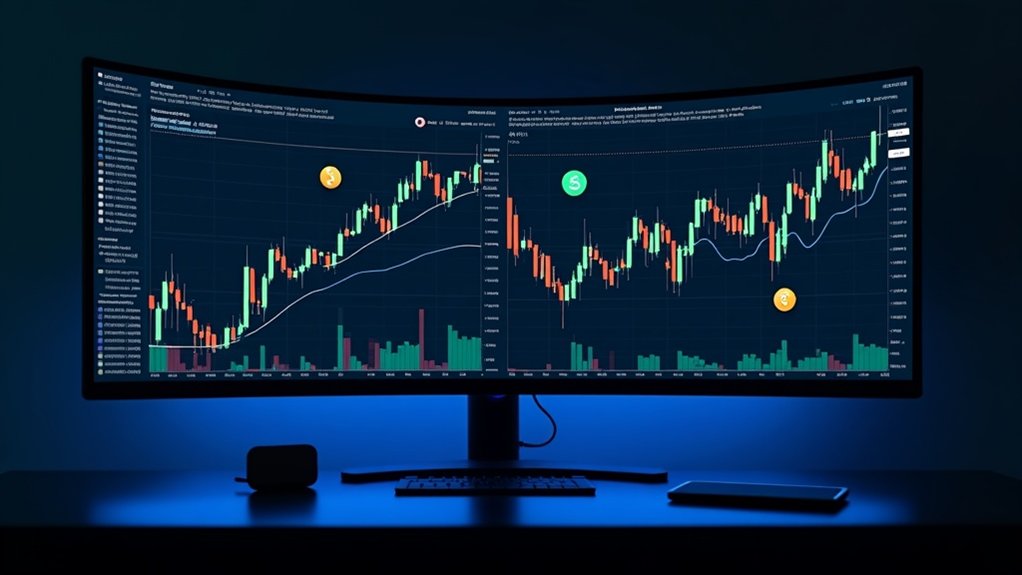A crypto exchange is a digital marketplace where people buy, sell, and trade cryptocurrencies. It connects buyers with sellers, just like a stock market does. Centralized exchanges (CEXs) like Binance hold users’ funds and require identity verification. Decentralized exchanges (DEXs) use blockchain smart contracts, letting users keep control of their assets. Security varies widely across platforms. Some exchanges handle billions in daily volume. The crypto world isn’t exactly known for simplicity or perfect safety.
A crypto exchange serves as the digital marketplace where cryptocurrency traders conduct their business. These platforms enable users to buy, sell, and swap digital currencies—whether for other cryptocurrencies or traditional money.
They’re basically the middlemen of the crypto world, connecting buyers with sellers through sophisticated trading mechanisms similar to what you’d find in stock markets. Without them? Good luck participating in the wild west of digital assets.
Exchanges come in different flavors. Centralized exchanges (CEXs) like Binance and Coinbase are run by companies that control everything. They hold your crypto, match your trades, and make you verify your identity through KYC requirements to ensure regulatory compliance. Very traditional. Very regulated.
Decentralized exchanges (DEXs), however, cut out the middleman entirely. No company controls your assets—just smart contracts on the blockchain. Your keys, your crypto. Period.
Then there are hybrid models trying to get the best of both worlds. These innovative platforms perform trade matching off-blockchain while still finalizing transactions on the blockchain itself. Can’t please everyone, but they’re trying.
P2P platforms take a different approach. Users create listings, negotiate directly, and use escrow systems to avoid getting scammed. CEXs offer a more accessible experience with user-friendly interfaces designed specifically for beginners unfamiliar with crypto trading. Instant exchangers like ShapeShift and Changelly just convert your crypto on the spot. Convenient, but you’ll pay for it.
Security is a big deal with these platforms. CEXs require two-factor authentication and strong passwords, but they’ve still been hacked. Millions gone in seconds.
DEXs avoid custody risks but require users to understand blockchain operations. Not exactly beginner-friendly.
The functionality varies widely between platforms. Some offer just basic trading. Others provide margin trading, futures, and other complex products.
Liquidity differs too—larger exchanges handle billions in daily volume, while smaller ones struggle to match orders quickly.
Bottom line: crypto exchanges are essential infrastructure for the digital asset ecosystem. They’re evolving rapidly as the market matures. Some will survive. Many won’t. That’s just how it goes in crypto.
Frequently Asked Questions
How Do Crypto Exchanges Make Money?
Crypto exchanges rake in cash through trading fees—the bread and butter of their business model.
They charge both makers and takers a percentage of each transaction.
Not enough? They’ll hit you with deposit and withdrawal fees too.
Then there’s the money from lending, borrowing, and staking services.
Don’t forget premium subscriptions and those hefty listing fees projects pay to get their tokens listed. Ka-ching!
What Security Measures Protect My Funds on Exchanges?
Exchanges protect funds through layered security. Multi-factor authentication blocks unauthorized access. Cold wallets—offline storage—house most crypto assets, away from hackers. Hot wallets maintain minimal funds for liquidity. Pretty smart.
Network security includes encryption, firewalls, and intrusion detection systems. Regular audits expose vulnerabilities. Suspicious activity monitoring flags potential threats. Proof of Reserves audits verify exchanges actually hold your assets. Shocking concept, right?
No system’s perfect though. Security breaches happen.
Can I Transfer Crypto Between Different Exchanges?
Yes, users can absolutely transfer crypto between exchanges.
Simple process, really. Select “withdraw” on the sending exchange, input the receiving exchange’s deposit address (correctly!), choose the right network for multi-chain tokens, and authorize with 2FA.
Fees are paid by the sender, varying with network congestion. Smart users do test transactions first.
Cross-chain transfers? More complex. They require bridges or atomic swaps. Miss a detail? Kiss your crypto goodbye. No second chances in blockchain land.
Are Crypto Exchanges Regulated by Government Authorities?
Yes, crypto exchanges are heavily regulated.
The SEC handles securities, CFTC oversees commodities, and FinCEN enforces anti-money laundering rules. It’s a regulatory soup.
Different agencies claim jurisdiction depending on how they classify the digital asset. States pile on with their own requirements too.
The President’s Working Group coordinates federal approaches. Exchanges get sued regularly for violations.
Clear rules? Not exactly. The regulatory landscape is evolving—and messy.
What Happens if a Crypto Exchange Goes Bankrupt?
When a crypto exchange goes bankrupt, customers’ assets become part of the bankruptcy estate. Plain and simple.
Investors transform into unsecured creditors—not exactly a promotion.
The exchange freezes withdrawals immediately, thanks to automatic stay protections.
A trustee takes control, liquidating crypto to pay creditors.
Customers might recover only pennies on the dollar after secured creditors get their cut.
Recent high-profile collapses like FTX? They’ve triggered regulatory crackdowns worldwide.
The crypto wild west is getting tamer.









